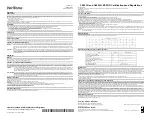
4. Configuration
96
Devices Configuration
The slave devices configuration (Figure 4-12), follows the parameters below:
Figure 4-12. Device General Parameters Settings
Configuration
Description
Default
Options
Slave Address
MODBUS slave address
1
0 to 255
Communication
Time-out (ms)
Defines the application level time-out
3000
10 to 65535
Maximum Number
of Retries
Defines the numbers of retries before
reporting a communication error
2
0 to 9
Table 4-48. Device Settings
Notes:
Slave Address:
According to the MODBUS standard, the valid slave addresses are from 0 to 247,
where the addresses from 248 to 255 are reserved. When the master sends a writing command with
the address configured as zero, it is making broadcast requests in the network.
Communication Time-out:
The communication time-out is the time that the master waits for a
response from the slave to the request. For a MODBUS RTU master device it must be taken into
account at least the following system variables: the time it takes the slave to transmit the frame
(according to the baud rate), the time the slave takes to process the request, send delay (if configured
in the slave), the transmission time of the response, and eventual delays caused by intermediate
devices, as repeaters, must also be regarded. It is recommended that the time-out is equal to or greater
than the time to transmit the frame plus the send delay the response and twice the processing time of
the request.
The following formula should be adopted to calculate estimated transmission time (ms):
Transmission Time (ms). = [1000 x (character count) x (bits per character) ] / Baud rate.
Maximum Number of Retries
: It sets the number of retries before reporting a communication error.
Example: In case the slave does not respond to the request and the master is configured to send three
retries, then the number of the errors counter will be increased in one at the end of the execution of
these 3 retries.
Mappings Configuration
The configuration of MODBUS relations (Figure 4-13), follows the parameters described in Table
4-49:
















































